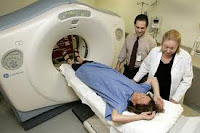 |
| photodynamic therapy |
The overall health of the patient is another factor that is taken into account when looking into treatments for lung cancer.
The objective of most treatment choices is to eliminate the disease or if that is not possible, extend the span and quality of the patient's life as much as possible. Some of the treatment options include conventional surgery, radiation treatment, cryosurgery, chemotherapy and photodynamic therapy (abbreviated PDT).
We will take a quick look at photodynamic therapy and radiation as possible treatments for lung cancer.
Photodynamic Therapy (PDT)
In this type of treatment, a special substance that is capable of being absorbed by the body cells is used in conjunction with a laser. This substance is injected into the bloodstream which allows it to spread to the cells in the body.
The chemical used for lung cancer treatment has the property of removing itself from normal cells quite quickly while lingering on in cancerous lung cells. A special laser is focused onto the cancer cells - this laser activates the substance. The result is that the cancer cells are destroyed while normal cells are left relatively intact.
Photodynamic Therapy is very useful in cases where surgical removal of the cancer is not possible. PDT can help relieve short breath caused by blockages in the airways. It can also control internal bleeding. This is one of the treatments for lung cancer used to provide relief from the symptoms of the disease.
PDT is also useful when the tumors are very small or when the patient cannot undergo some of the other conventional treatments for lung cancer.
Radiation Therapy
High energy radiation can kill cancerous cells - that is the essence of radiation therapy. Radiation treatment involves focusing radiation onto a precise area that contains the cancer tumor. This results in the cancer cells being killed.
In many cases, radiation is used along with surgical interventions. Sometimes, even after surgery, the patient may still have some cancerous cells within his lungs. Radiation can then be used to eliminate those cells.
Radiation is also used to reduce the size of tumors prior to surgery. This makes surgery easier and possibly more effective.
Radiation and chemotherapy are often used together, particularly in cases where surgery is not possible. It is possible to reduce lung cancer symptoms like shortness of breath through radiation, which can shrink tumors and remove obstructive growths.
Radiation is generally applied using special machines. Some types of treatments for lung cancer make use of radiation from a device that is implanted within the body, at the site of the tumor. Such devices contain radioactive material. This material comes into contact with the tumor and destroys it.
Newer kinds of treatments for lung cancer are likely to become available in the coming years, as the continued research efforts aimed at curbing this disease yields results.




